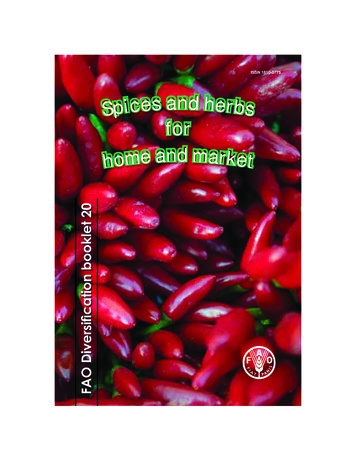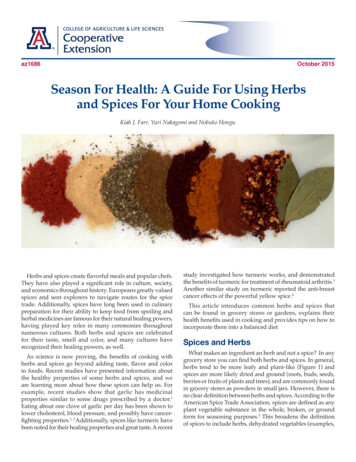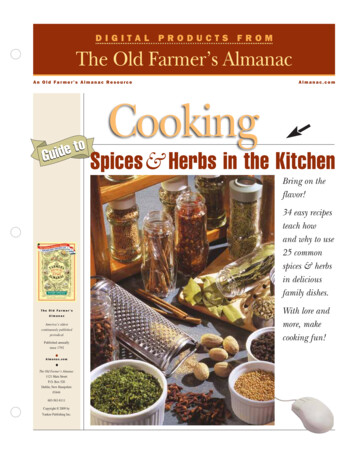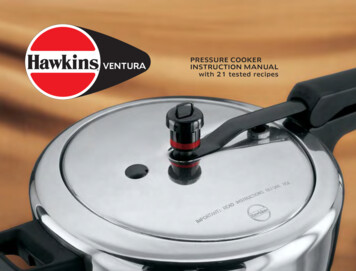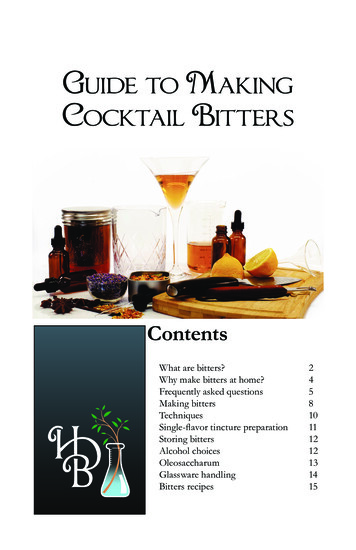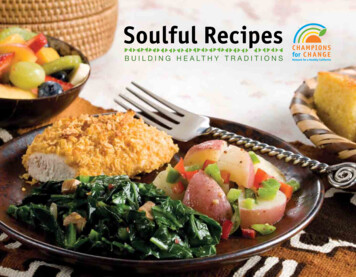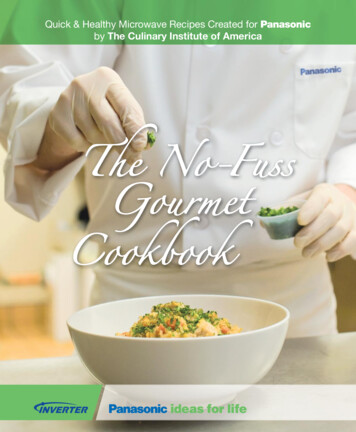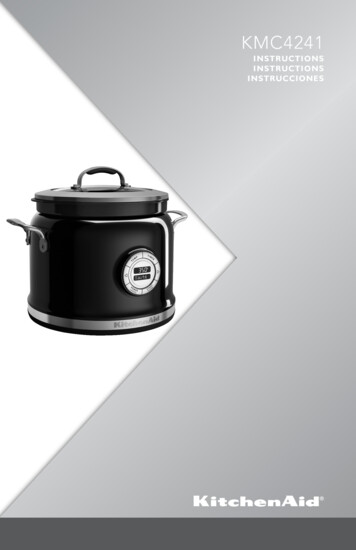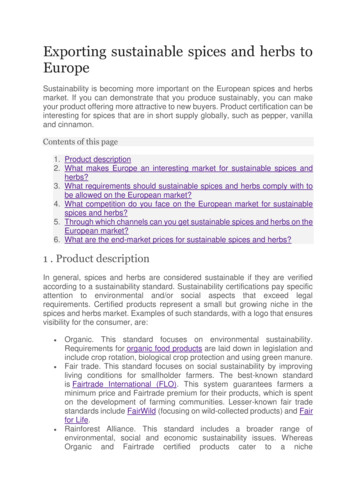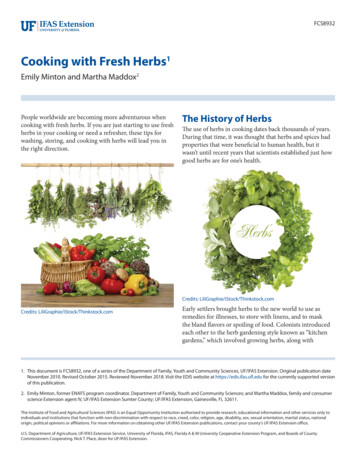
Transcription
FCS8932Cooking with Fresh Herbs1Emily Minton and Martha Maddox2People worldwide are becoming more adventurous whencooking with fresh herbs. If you are just starting to use freshherbs in your cooking or need a refresher, these tips forwashing, storing, and cooking with herbs will lead you inthe right direction.The History of HerbsThe use of herbs in cooking dates back thousands of years.During that time, it was thought that herbs and spices hadproperties that were beneficial to human health, but itwasn’t until recent years that scientists established just howgood herbs are for one’s health.Credits: LiliGraphie/iStock/Thinkstock.comCredits: LiliGraphie/iStock/Thinkstock.comEarly settlers brought herbs to the new world to use asremedies for illnesses, to store with linens, and to maskthe bland flavors or spoiling of food. Colonists introducedeach other to the herb gardening style known as “kitchengardens,” which involved growing herbs, along with1. This document is FCS8932, one of a series of the Department of Family, Youth and Community Sciences, UF/IFAS Extension. Original publication dateNovember 2010. Revised October 2015. Reviewed November 2018. Visit the EDIS website at https://edis.ifas.ufl.edu for the currently supported versionof this publication.2. Emily Minton, former ENAFS program coordinator, Department of Family, Youth and Community Sciences; and Martha Maddox, family and consumerscience Extension agent IV, UF/IFAS Extension Sumter County; UF/IFAS Extension, Gainesville, FL 32611.The Institute of Food and Agricultural Sciences (IFAS) is an Equal Opportunity Institution authorized to provide research, educational information and other services only toindividuals and institutions that function with non-discrimination with respect to race, creed, color, religion, age, disability, sex, sexual orientation, marital status, nationalorigin, political opinions or affiliations. For more information on obtaining other UF/IFAS Extension publications, contact your county’s UF/IFAS Extension office.U.S. Department of Agriculture, UF/IFAS Extension Service, University of Florida, IFAS, Florida A & M University Cooperative Extension Program, and Boards of CountyCommissioners Cooperating. Nick T. Place, dean for UF/IFAS Extension.
vegetables and flowers, in gardens just outside the kitchendoor for convenience and safety. To colonists, herbs wereas important to their health, and the quality of their food,as were vegetables. The interest in herbs continued throughthe Revolutionary War to the presidency of Thomas Jefferson, who grew 26 kinds of herbs in his personal kitchengarden. As civilizations continued to grow, so did theunderstanding of how to utilize the abundant variety offresh herbs in cooking.Herbs are the leaves of temperate climate plants; temperateclimates have summers and winters of similar length.Examples of herbs include basil, thyme, sage, rosemary, andoregano. Today, herbs often are used in cooking to enhancethe flavor of foods without the addition of extra fat, sugar,or sodium.Buying Fresh HerbsWashing Fresh HerbsIt is important to wash herbs before cooking or storingthem to remove dirt or grit. Rinse small portions undercool, running water. Once all the dirt has been washedaway, gently shake the herbs or carefully spin dry them in asalad spinner. Remove excess water by lightly patting with adry paper towel.For larger herb bundles, fill a clean sink or a large, deepbowl with cool water. Place the herbs in the water and movethem around to get rid of any dirt. Remove the herbs fromthe dirty water, drain, refill with clean water, and continuethe washing processes. Follow the previous steps until yourwater is clear and no dirt is left behind. To dry, you caneither gently shake the herbs or carefully spin dry them ina salad spinner. Again, remove any excess water by lightlypatting with a dry paper towel.It is best to buy herbs close to the time when you will usethem to ensure their freshness. Also, if possible, buy herbsin small bundles or packages so you will be able to use thembefore they lose their peak flavor. If buying a small quantityis not an option, split the bundle with friends or family,plan your next week’s meals around the herbs you bought,or dry what isn’t unused!Look for herbs that are rich in color and aroma. Theyshould smell fresh and crisp, not musty, and shouldn’t bewilted or discolored. If you are unsure of their quality,remove a few of the stems from the bunch. If the stemsalone can support the leaves, the herbs are fresh. If thestems wilt, it would be best to pick a different bunch.Fresh herbs are available at local supermarkets and farmersmarkets. Stock may be limited in small grocery stores.Herbs come packaged in loose plastic bags, tied in bunches,or in plastic containers. At the supermarket, fresh herbs canbe found in or near the fresh vegetable section.Credits: Michael Blann/DigitalVision/Thinkstock.comStoring Fresh HerbsThe longer herbs are stored, the less appealing and flavorfulthey become. If you buy herbs a few days before you willuse them, it is important to refrigerate the herbs properly toconserve their color and flavor.Credits: AlexRaths/iStock/Thinkstock.comCooking with Fresh HerbsMake sure any ties or rubber bands are removed fromthe herb bundles before storing. Throw away leaves thatare discolored or limp. In order to extend the freshnessof the herbs for about one week, cut the stems diagonallyas if you were cutting flower stems. Place the newly-cutstems in a jar, vase, or tall glass with one to two inches ofwater. Cover the herbs with a plastic bag, leaving space2
for air to circulate. Another way to store herbs is to simplyplace them in an open or only partly-closed plastic bag orcontainer. Whichever method you choose, be careful toavoid crushing your herbs. Also, store your herbs in thewarmest part of your refrigerator to avoid the possibility offreezing.There is no general rule about how much to use. Mostrecipes specify an amount in the list of ingredients. Keep inmind that it is okay to use more or less than the recipe callsfor, but until you know how your taste buds will react to theflavor of the herbs, it is best to start with small amounts andadd more if desired.If you don’t plan on using the herbs within a week ofpurchase, it may be best to freeze them. You can followthese easy steps for freezing fresh herbs from the NationalCenter for Home Food Preservation:If you don’t have a recipe to follow, start with ¼ teaspoonand add more as needed to reach your ideal flavor. Youdon’t want the herbs to overpower the other flavors in thedish. When doubling a recipe, do not double the herbs orspices. Increase their amounts by 1½. If a recipe calls fordried herbs, you can substitute fresh herbs. Dried herbs arestronger than fresh herbs so you will need to use more ofthe fresh herbs. If the recipe calls for 1 teaspoon of dried,crushed herbs or ¼ teaspoon of powdered herbs, use 3teaspoons (1 tablespoon) of fresh. The following dried-herbblends are great to try with any dish. Remember to adjustthe amount when using fresh herbs. Wash, drain, and pat dry with paper towels. Wrap a few sprigs or leaves in freezer wrap and place in afreezer bag. Seal and freeze.Another effective way to freeze herbs is to chop them, putthem in ice cube trays, cover with water, and freeze. The icearound them seals out air and helps preserve their flavorand aroma. Thaw as many cubes as needed for your nextdish.Make sure to label the freezer bag with the name of theherb and the date. Fresh herbs tend to lose their color andbecome wilted during freezing, causing all herbs to lookthe same. Herbs that have been frozen are generally usedin cooked meals rather than as a garnish because of theirappearance.Salt-Free Blend—makes about ⅓ cup1 tablespoon mustard powder2 teaspoons parsley2 teaspoons onion powder2 teaspoons thyme1 tablespoon garlic powder2 teaspoons dill weed2 teaspoons savory2 teaspoons paprika2 teaspoons lemon peelCooking with Fresh HerbsMany people are hesitant when it comes to cooking withfresh herbs because they are unsure of which ones and howmuch to use, how to prepare the herbs, and when to addduring the cooking process. However, using fresh herbswhen you cook is a great way to minimize unhealthy foodadditives, especially salt, and add new flavors to your classicdishes.Credits: Polka Dot Images/Polka Dot/Thinkstock.comCredits: mythja/iStock/Thinkstock.comCooking with Fresh Herbs3
Italian Seasoning—makes about1½ cups½ cup dried oregano½ cup dried basil¼ cup dried parsley1 tablespoon fennel seeds, crushed2 tablespoons dried sage1 tablespoon hot red pepper flakesGarden Blend—makes about 1¼ cup3 tablespoons dried parsley3 tablespoons dried basil3 tablespoons dried thyme3 tablespoons dried marjoram3 tablespoons dried rosemary3 tablespoons dried chives3 tablespoons paprika½ teaspoon garlic powderHerbs de Provence (used for marinating and grillingmeats)—makes about 2 cups½ cup dried rosemary½ cup dried thyme¼ cup dried marjoram¼ cup dried oregano¼ cup dried savory2 tablespoons dried lavender leaves2 tablespoons dried fennel seeds or stalksCredits: Ingram Publishing/Thinkstock.comCredits: nitrub/iStock/Thinkstock.comPoultry Herbs—makes about ⅓ cup2 tablespoons dried tarragon1 tablespoon dried marjoram1 tablespoon dried basil1 tablespoon dried rosemary1 teaspoon paprika1 teaspoon dried lovageFish Herbs—makes about ½ cup3 tablespoons dried dill weed2 tablespoons dried basil1 tablespoon dried tarragon1 tablespoon dried lemon thyme1 tablespoon dried parsley1 tablespoon dried chervil1 tablespoon dried chivesCooking with Fresh HerbsRecipes generally tell us how to prepare our herbs.Examples include mince, dice, chop, or whole leaf. If nodirections are given, it is common to mince or finely chopthe herbs. Mincing causes more of the herb’s flavor to beexposed. This can be done with a sharp knife or by using apair of kitchen scissors to snip the herbs.The timing of the addition of fresh herbs during recipepreparation depends on the herb being used and if the dishbeing prepared is hot or cold. For hot dishes, fresh herbsare added near the end of the cooking time or just beforeserving to retain their flavor and aroma. Delicate herbs suchas basil, cilantro, and dill should be added during the lastone to two minutes of cooking or right before the dish isserved. Less delicate herbs including rosemary and thymecan be added during the last 20 minutes of cooking. Forsome cooking processes, the herbs are added toward thebeginning. Most recipes indicate the best time to add herbs.For cold dishes such as salads, dips, dressings, and variousdesserts, the herbs should be added several hours beforeserving or overnight.4
Common Herb and FoodCombinationsEach herb has its own unique flavor but can add zest toa variety of different foods. Below is a list of commonherb and food combinations. Remember, this list is only aguideline—once you become familiar with these and otherherbs, feel free to try your own combinations!Credits: LiliGraphie/iStock/Thinkstock.comBasil—Tomato products (juice, pasta sauces, pizzasauce, etc.), eggs, game meats, lamb, veal, rice, spaghetti,vinaigrette, soups (minestrone, pea, potato, and vegetable),beans, eggplantThyme—Eggs, game meats, lamb, veal, rice, poultry,barbeque sauce, fish, oysters, chowders, soups (onion,tomato, and vegetable), mushrooms, tomatoesRosemary – Dumplings, eggs, game meats, lamb, veal,poultry, fish, barbeque sauce, chicken, beef, soups (peaand vegetable), beans, mushrooms, potatoes, cauliflower,turnipsMint—Desserts, lamb, peas, fruit salads, saucesRecipes Using HerbsFresh herbs can be used in a variety of dishes to enhancethe flavor without the addition of extra salt, sugar, or fat.Give the following recipes a try and see what you think!Vegetable Pasta w/ Tomatoes1 medium zucchini, washed and ends removed1 medium onion, peeled and chopped2 cloves garlic, peeled and chopped1 tablespoon olive oil 1 tablespoon dried leaf basil, crushed½ teaspoon coarsely ground black pepper2 cups prepared no-fat pasta sauce1 cup chopped fresh tomatoes8 ounces dried pasta, shape of choice1 tablespoon chopped fresh parsley or basilgrated Parmesan cheese, optionalCut zucchini in quarters lengthwise and cut into ½-inchpieces. Place zucchini, onion, garlic, and olive oil withseasonings in large, deep skillet and sauté; over MEDIUMheat until soft. Stir often. Add prepared sauce, mix well, andlet simmer for 5 minutes. Stir in ½ cup chopped tomato andallow to heat thoroughly.In a separate pot, cook pasta as directed on package. Drainwell and place in large serving bowl. Add sauce and mixgently. Top with the reserved ½ cup chopped tomatoes andchopped herbs. Serve hot. (Serves 4)Calories: 320; Fat: 5g; Sodium: 402mgOregano—Tomato dishes, beef, game meats, veal, spaghetti, clams, soups (bean, minestrone, and tomato), beans,eggplant, and mushroomsDill—Tomato dishes, yeast breads, eggs, coleslaw, potatosalad, fish, beans, Brussels sprouts, cauliflower, cucumber,summer squashParsley—Salads, vegetables, pastasSage—Cottage cheese, game meats, pork, rice, poultry,soups (chicken, minestrone, and vegetable), stuffingCredits: dulezidar/iStock/Thinkstock.comCilantro—Mexican and Asian cooking, rice, salsa,tomatoesCooking with Fresh Herbs5
Roasted Squash and Eggplant Casserole with Chicken1 medium eggplant1½ tablespoons olive oil1 tablespoon balsamic vinegar1 fresh lemon, juiced4 cloves garlic1 teaspoon fresh parsleyblack pepper, to taste½ cup fresh basil, chopped2 medium size chicken breasts, pre-cooked and cubed1 cup canned tomato saucesprinkle lightly with salt if desired. Stuff ¼ of the cherrymixture into each pocket; close opening with metal skewersor wooden picks. Combine oil, vinegar, garlic salt, andpepper; mix well. Marinate stuffed chicken breasts ½ hourin refrigerator. Broil or grill chicken breasts, brushing withmarinade, until fully cooked and juices run clear whensliced.Preheat oven to 350ºF. Slice squash and eggplant lengthwise. In a bowl mix the oil, vinegar, lemon juice, garlic,parsley, black pepper. Brush squash and eggplant with thisseasoning mixture. Grill vegetables for two to three minuteson each side, or roast them in the oven under the broiler.Arrange squash, eggplant, basil, and chicken in an 8” x 8”cooking dish and cover with tomato sauce. Bake 20 to 30minutes, or until thoroughly heated. (Serves 4)Calories: 229; Fat: 13g; Sodium: 767mgOven Method: Brown the stuffed chicken in an oven-safeskillet on both sides. Bake at 375ºF 12 to 15 minutes or untiljuices run clear. (Serves 4)Calories: 170; Fat: 7g; Sodium: 492mgCredits: Elena Danileiko/iStock/Thinkstock.comCredits: BravissimoS/iStock/Thinkstock.comCherry Stuffed Grilled Chicken1½ cups pitted and coarsely chopped fresh sweet cherries(if fresh cherries are not available use frozen cherries; thawin refrigerator the day before and drain excess liquid)¼ cup chopped onion1 teaspoon chopped fresh sage½ teaspoon each salt and chopped fresh thyme4 boneless, skinless chicken breast halves (4 to 6 ounceseach)3 tablespoons olive oil2 tablespoons white wine vinegar1½ teaspoons garlic salt½ teaspoon coarsely ground pepperCombine cherries, onion, sage, salt and thyme; mix well.Cut a pocket on the thicker side of each chicken breast;Cooking with Fresh HerbsFresh Tomato and Pita Chip SaladDressing4 tablespoons chopped fresh parsley2 tablespoons grated lemon rind4 teaspoons chopped fresh mint1 cup thinly sliced green onions1 tablespoon extra virgin olive oil¼ teaspoon saltSalad1 pound romaine lettuce, shredded (about 6 cups)2 to 3 medium fresh tomatoes, cubed (about 3 cups)1 cucumber, peeled, quartered lengthwise, and thinly sliced2 whole wheat pitas (6½ inches diameter)For dressing, combine parsley, lemon rind, mint, and greenonions with olive oil and salt in small bowl. Mix well andlet stand at least one hour. Meanwhile, combine lettuce,6
tomatoes, and cucumber in a large bowl; refrigerate to chill.Preheat oven to 400ºF.Arrange pitas in a single layer on baking sheet. Bake sixminutes, or until lightly toasted. Break into bite-sized piecesand set aside. When ready to serve, add pita chips to saladmixture and toss with dressing. (Serves 3)Simmer potatoes until tender; drain and cool. Quarter thepotatoes lengthwise and set aside. In large sauté pan heatoil, add garlic and sauté for 30 seconds. Add rosemary,lemon zest, and chili flakes; sauté until fragrant. Addpotatoes and beans; sauté until vegetables are hot andcoated with seasonings. Sprinkle with lemon juice andseason lightly with salt. Serve warm. (Serves 3)Calories: 241; Fat: 6g; Sodium: 453mgCalories: 317; Fat: 19g; Sodium: 416mgCreamy Blueberry Shake2 cups blueberries, fresh or frozen (washed and sorted, iffresh)2 small bananas, ripe⅓ cup honey2 tablespoons lemon juice1½ cups low-fat vanilla yogurt1 cup low-fat vanilla ice cream4 sprigs mintCombine blueberries, bananas, honey and lemon juice andpurée on HIGH speed in blender. Add yogurt and ice creamand blend until thick and smooth. Serve immediately incold glasses decorated with sprigs of mint. (Serves 3)Credits: Ls9907/iStock/Thinkstock.comGreen Beans and Potatoes1 pound red potatoes¼ cup olive oil1 tablespoon chopped garlic1½ tablespoons finely chopped rosemary1 teaspoon grated lemon zest¼ teaspoon red chili flakes1 pound green beans,trimmed and blanched2 teaspoons lemon juiceSaltCalories: 423; Fat 4g; Sodium 108mgCredits: baibaz/iStock/Thinkstock.com*Recipes from : arinahabich/iStock/Thinkstock.comCooking with Fresh Herbs7
References & ResourcesUniversity of Nebraska Cooperative Extension in LancasterCounty. (2010). Food Reflections: Healthy Cooking withFresh Herbs. http://lancaster.unl.edu/food/ftapr03.htmSpano, M. Cooking with Herbs & Spices More Flavor,Better Health. Diabetes Self Management Jan.–Feb. 2009:12–19.Templeton, B.E., L.E. Moody, and L.B. Bobroff. Nutritionfor Health and Fitness: Alternative Seasonings (FCS8096–In Archive). Gainesville: University of Florida Institute ofFood and Agricultural Sciences.The National Center for Home Food Preservation www.uga.edu/nchfp/how/freeze/herbs.htmlFruits and Veggies: More Matters www.fruitsandveggiesmorematters.orgCooking with Fresh Herbs8
Common Herb and Food Combinations Each herb has its own unique flavor but can add zest to a variety of different foods. Below is a list of common herb and food combinations. Remember, this list is only a guideline—once you become familiar with these
